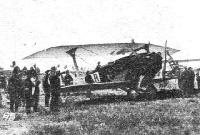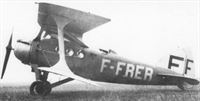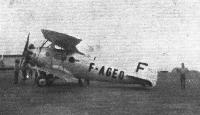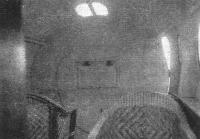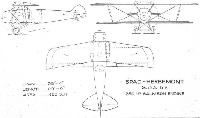
Описание
Страна : Франция
Год : 1920
Пассажирский самолет с экипажем из одного пилота
Bleriot-SPAD S.33, S.46, S.56 и S.66
В августе 1914 года компания "Societe Bleriot-Aeronautique" приобрела фирму SPAD ("Societe Pour les Appareils Deperdussin"), оказавшуюся на краю банкротства после того, как ее владелец Арман Депердюссен был арестован за финансовые махинации. Блерио сменил название фирмы на "Societe Anonyme Pour l'Aviation et ses Derives", сохранив при этом прежнюю аббревиатуру. На протяжении Первой мировой войны Блерио позволял выпускать фирме самолеты под собственным названием, но в 1921 году SPAD вошла в состав основной компании, которая стала называться "Bleriot-SPAD".
Первым опытом в создании транспортных самолетов для компании стал S.27, построенный в количестве нескольких экземпляров. За ним последовал Bleriot-SPAD S.33, прототип которого взлетел 12 декабря 1920 года. Оба самолета были оснащены двигателем воздушного охлаждения Salmson мощностью 250 л. с. (186 кВт), но на последнем позднее установили более мощную (260 л.с, 194 кВт) версию этого мотора. В закрытой кабине размещались четыре пассажира, а за ней располагалась открытая кабина, в которой сидели пятый пассажир (по правому борту) и пилот. Один S.33 был переделан для обучения полетам по приборам, обучаемый сидел внутри зашторенной кабины.
S.33 оказался удачным самолетом - была построена 41 машина, которые вместе со своими вариантами доминировали на европейском рынке небольших транспортных самолетов до начала 1930-х годов. Первым из вариантов стал самолет S.46, летные характеристики которого улучшили установкой двигателя Lorraine-Dietrich 12Da мощностью 370 л.с. (276 кВт) и крыла увеличенного размаха. За первым прототипом, взлетевшим 16 июня 1921 года, последовало еще 38 серийных машин.
Самолет S.56, прототип которого взлетел 3 февраля 1923 года, представлял собой вариант S.33 с крылом металлической конструкции и двигателем воздушного охлаждения Gnome-Rhone (Bristol) Jupiter мощностью 380 л.с. (283 кВт). В пассажирской кабине изменили положение кресел и добавили вторую дверь.
За прототипом последовали единственный S.56/2 с двигателем Jupiter мощностью 400 л.с. (298 кВт), восемь S.56/3 с мотором мощностью 380 л.с. (283 кВт) и доработанным шасси и S.56/4, конструкция которого претерпела существенные изменения. Кабина пилота (и пассажира) размещалась сразу за двигателем Jupiter мощностью 420 л.с. (313 кВт), а позади нее располагалась пассажирская кабина на шесть человек. Доработали и конструкцию крыла. Всего построили восемь S.56/4, а еще два переделали из S.56/3. У самолета S.56/5, впервые взлетевшего в 1928 году, пассажирская кабина делилась на два отсека: в переднем размещались четыре пассажира, а в заднем - два, но последний отсек мог использоваться и для перевозки грузов. Шесть S.56/3 были переделаны в этот вариант. Последней версией стал S.56/6, построенный в количестве двух экземпляров. Этот четырехместный самолет с кабиной пилота, снова перенесенной назад, выпускался специально для компании "Air-Publicite" и предназначался для буксировки рекламных баннеров.
Восемь S.33 были позднее переделаны в вариант S.66, с заголовниками-обтекателями для пилота и сидящего рядом с ним пассажира.
Варианты
S.48: один S.33 некоторое время летал с двигателем Lorraine мощностью 275 л.с. (205 кВт)
S.50: два прототипа с двигателями Hispano-Suiza 8Fb мощностью 300 л.с (224 кВт), позднее в этот вариант переделали еще три S.33. Один из прототипов, оснащенный крылом от S.46, использовался как правительственный транспорт
S.86: один S.66 в 1925 году оснащен двигателем Lorraine мощностью 450 л.с. (336 кВт)
S.116: 32-й S.66 оснащен в 1928 году мотором Renault 12Ja мощностью 450 л.с. (336 кВт) вместо Lorraine-Dietrich
S.126: S.86 в 1929 году оснащен двигателем Hispano-Suiza 12На мощностью 450 л.с. (336 кВт)
ТАКТИКО-ТЕХНИЧЕСКИЕ ХАРАКТЕРИСТИКИ
Bleriot-SPAD S.33
Тип: пассажирский самолет с экипажем из одного пилота
Силовая установка: один двигатель воздушного охлаждения Salmson СМ.9 мощностью 260 л. с. (194 кВт)
Летные характеристики: максимальная скорость 180 км/ч на оптимальной высоте; крейсерская скорость 160 км/ч на оптимальной высоте; потолок 3800 м; дальность полета 1080 км
Масса: пустого 1050 кг; максимальная взлетная 2062 кг
Размеры: размах крыла 11,66 м; высота 9,08 м; высота 3,20 м; площадь крыльев 42,18 мг
Полезная нагрузка: до 5 пассажиров
Описание:
- Bleriot-SPAD S.33, S.46, S.56 и S.66
- Flight, July 1921
THE SPAD "BERLINE" S.33 BIS
Фотографии
-
Мировая Авиация 58
Регистрационный номер: F-AIEP [2] Изображен S.33, в 1933 году использовавшийся французской авиакомпанией CIDNA ("Compagnie Internationale de Navigation Aerienne"). Самолеты этого типа составляли основу парка компании, эксплуатировавшегося на европейских авиалиниях.
-
Aeroplane Monthly 1983-11 / J.Stroud - Wings of Peace
Регистрационный номер: F-CMAZ F-CMAZ, the prototype Bleriot Spad 33, seen with intermediate-type fin. The awkwardly-positioned cabin door can be seen open.
-
Aeroplane Monthly 1983-11 / J.Stroud - Wings of Peace
Регистрационный номер: F-ACMA [5] The first production Spad 33, F-ACMA. In this view it is seen with the final form of fin and rudder. The cabin windows differ from those of the prototype and other production examples.
-
Flight 1921-07 / Flight
Регистрационный номер: F-ACMA [5] THE SPAD "BERLINE": Three-quarter front view.
-
Flight 1921-07 / Flight
Регистрационный номер: F-ACMA [5] THE SPAD "BERLINE": Three-quarter rear view. Note the two petrol tanks on the top plane.
-
Aeroplane Monthly 1989-04 / J.Stroud - Wings of Peace
Регистрационный номер: F-AHDI, F-AICC The CIDNA C.81 F-AGGF at Le Bourget in 1928 with the C.61bis F-AFCN and F-AFBX. Note the enlarged tail surfaces of the C.81. CIDNA’s Bleriot Spad 33 F-AICC is at the edge of the apron and F-AHDI on the right was a Bleriot Spad 66.
Другие самолёты на фотографии: Caudron C.61 / C.81 / C.183 - Франция - 1921
-
Aeroplane Monthly 1983-11 / J.Stroud - Wings of Peace
Регистрационный номер: F-FREE, F-FREF [2] Cie. Franco-Roumaine de Navigation Aerienne's silver-painted Bleriot Spad 33, F-FREE or F-FREF, at Le Bourget.
-
Air-Britain Archive 1980-01
Регистрационный номер: O-BAHE Bleriot Spad S.33 O-BAHE (61) a Bleriot Spad which was destroyed in the Evere fire after two months service with SNETA.
-
Flight 1921-12 / Flight
Регистрационный номер: F-FREF [2] THE SECOND CZECH INTERNATIONAL AERO EXHIBITION AT PRAGUE: Bleriot-Spad Limousine, exhibited by the Compagnie Franco-Roumaine de Navigation Aerienne.
-
Flight 1922-06 / Flight
The race for the Coupe Lamblin was over the circuit Paris, Brussels, London, Paris. Our photograph shows Jean Casale on a Spad-Herbemont. Note his engine being started by the aid of the Odier starter.
-
Aeroplane Monthly 1983-11 / J.Stroud - Wings of Peace
Регистрационный номер: F-FRER [2] The Bleriot Spad 46 F-FRER was a Spad 33 conversion.
-
Aeroplane Monthly 1983-11 / J.Stroud - Wings of Peace
Регистрационный номер: F-FRER [2] CIDNA’s Bleriot Spad F-FRER at Dubendorf Airport, Zurich.
-
Aeroplane Monthly 1983-11 / J.Stroud - Wings of Peace
Регистрационный номер: F-ADAR F-ADAR was almost certainly the prototype Bleriot Spad 50. No construction number has been traced for this aeroplane and it may have been a converted Spad 33.
-
Aeroplane Monthly 1983-11 / J.Stroud - Wings of Peace
A RECORD-BREAKER: The Spad 56 on which Casale has recently established world's altitude records. The machine is fitted with a Bristol "Jupiter" engine, manufactured in France by the Gnome and Rhone Co.
The prototype Bleriot Spad 56, with Gnome-Rhone Jupiter engine. -
Aeroplane Monthly 1983-11 / J.Stroud - Wings of Peace
The nose, undercarriage and cabin area of the Bleriot Spad 56/1 before the addition of extra windows.
-
Flight 1925-11 / Flight
Регистрационный номер: F-AGEO The Bleriot-Spad 56, with Bristol "Jupiter" engine, which flew from Paris to Teheran in 34 flying hours.
-
Aeroplane Monthly 1983-11 / J.Stroud - Wings of Peace
Регистрационный номер: F-AIEP [2] CIDNA’s Bleriot Spad 56 F-AIEP was originally built as a Spad 56/3 and is seen here as a 56/5 incorporating 56/4 improvements with forward cockpit and improved passenger accommodation.
-
Flight 1926-05 / Flight
CROYDON DURING THE STRIKE: The general strike resulted in a vast increase in the air traffic between Croydon and the Continent and a great number of extra machines were called into service. Shown a line-up of machines, among which may be recognised two Farman "Goliaths," a Spad, and two Handley-Page W.10's.
Другие самолёты на фотографии: Farman F.60 Goliath / F.169 - Франция - 1918Handley Page H.P.18 (W.8) / H.P.30 (W.10) - Великобритания - 1919
-
Flight 1921-07 / Flight
THE SPAD "BERLINE": View inside the cabin, looking forward. Note emergency exit in roof.
-
Aeroplane Monthly 1983-11 / J.Stroud - Wings of Peace
Looking aft in the passenger cabin of a Bleriot Spad 56/4.
-
Aeroplane Monthly 1983-11 / J.Stroud - Wings of Peace
Регистрационный номер: F-AEGF KEITH WOODCOCK'S painting of a Cie. Franco-Roumaine de Navigation Aerienne Bleriot Spad 46 F-AEGF.
-
Flight 1921-07 / Flight
SPAD-Herbemont S.33 bis 250 hp Salmson Engine
- Фотографии











